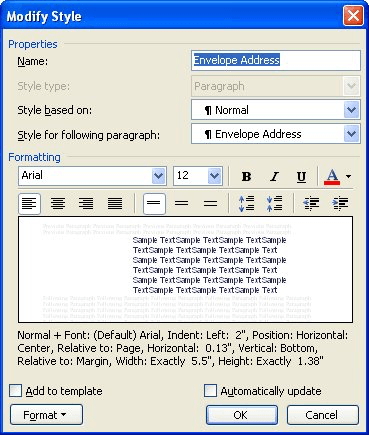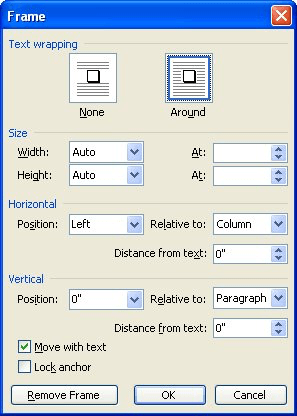Please Note: This article is written for users of the following Microsoft Word versions: 97, 2000, 2002, and 2003. If you are using a later version (Word 2007 or later), this tip may not work for you. For a version of this tip written specifically for later versions of Word, click here: Changing the Return Address Location.
Word includes an Envelopes feature that makes it pretty easy to create your own professional-looking envelopes. The feature makes certain assumptions about where different parts of the envelope should be printed, but what if you want to change the positioning of the return address?
The Envelopes and Labels tool in Word depends on a predefined style when creating an envelope. The style used for the return address, appropriately enough, is named Envelope Return. When you click on either the Print or Add to Document buttons in the Envelopes and Labels dialog box, this style is grabbed and used for the return address area itself.
The style is defined to use a frame, and that frame is defined to appear at a very specific location on the envelope. If you want to change where the return address appears, simply change where the frame is defined to appear. To do this, use these steps if you are using Word 2002 or Word 2003:

Figure 1. The Modify Style dialog box.

Figure 2. The Frame dialog box.
If you are using Word 97 or Word 2000 the steps are a bit different:
Now, when you save your document or close Word, you are asked if you want to save your changes to the template. Make sure you do this. Your envelopes, when created in a document that uses this template, should now have your return address exactly where you specified.
WordTips is your source for cost-effective Microsoft Word training. (Microsoft Word is the most popular word processing software in the world.) This tip (898) applies to Microsoft Word 97, 2000, 2002, and 2003. You can find a version of this tip for the ribbon interface of Word (Word 2007 and later) here: Changing the Return Address Location.

Create Custom Apps with VBA! Discover how to extend the capabilities of Office 365 applications with VBA programming. Written in clear terms and understandable language, the book includes systematic tutorials and contains both intermediate and advanced content for experienced VB developers. Designed to be comprehensive, the book addresses not just one Office application, but the entire Office suite. Check out Mastering VBA for Microsoft Office 365 today!
When you create an envelope, Word assumes you want to use the font it has decided should be used for the envelope. If you ...
Discover MoreWord allows you to print return addresses on your envelopes. You may run across a scenario where the return address is ...
Discover MoreWant to save a bunch of envelopes in a single document so that you can print them all out as a group? Here's how to ...
Discover MoreFREE SERVICE: Get tips like this every week in WordTips, a free productivity newsletter. Enter your address and click "Subscribe."
There are currently no comments for this tip. (Be the first to leave your comment—just use the simple form above!)
Got a version of Word that uses the menu interface (Word 97, Word 2000, Word 2002, or Word 2003)? This site is for you! If you use a later version of Word, visit our WordTips site focusing on the ribbon interface.
Visit the WordTips channel on YouTube
FREE SERVICE: Get tips like this every week in WordTips, a free productivity newsletter. Enter your address and click "Subscribe."
Copyright © 2026 Sharon Parq Associates, Inc.
Comments